You may not find this terribly rewarding unless you're included here, so this is a good time for casual and random browsers to turn back before they get too caught up in the sweep and majesty of the proceedings and can't let go.

An early start in the late morning from our digs in Montegiardino, 15 December 2017

This is still called the 'castle' and was apparently part of a castle complex, as with the other 'castles' or municipalities that make up the modern Republic of San Marino. Montegiardino is the last of the properties added to the Republic -- it was one of the Malatesta castles but was besieged in 1463 by the Sammarinese (San Marino folks) and the troops of the famous warlord Federico da Montefeltro, later Duke of Urbino, following which San Marino absorbed Montegiardino and its fortifications were destroyed.

Ruins of the castle were discovered in 1647 by the pastor of the church, which was outside its walls.

A quick detour up the road to make a rendezvous at the coiffeuse for a few days hence
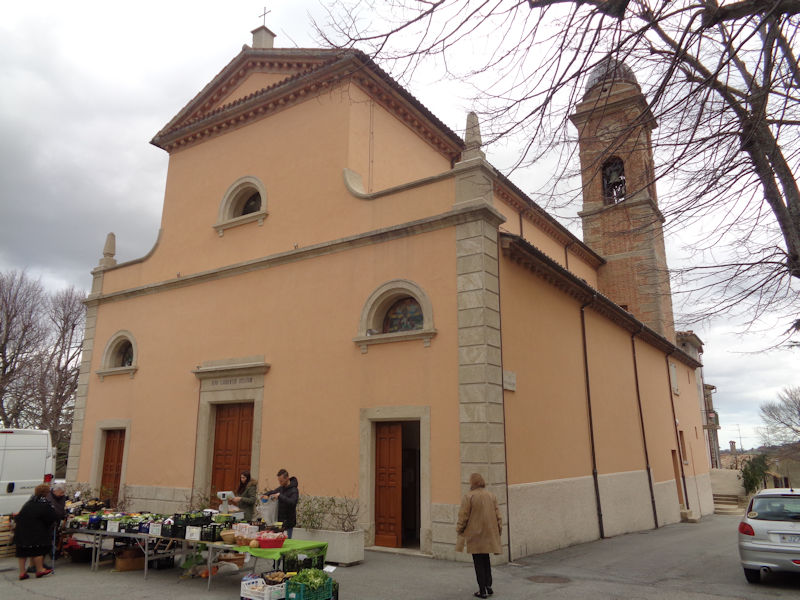
We've just time for a quick look into the church, with its small vegetable market proceeding smoothly in the carpark.

A small nave with two aisles

So that was fun, now for the 'castello'.

The entry is signposted as the 'way up to the castle' so here we go. The coat of arms over the arch are those of Montegiardino:


Into the warren of medieval streets in what remains of the castle complex

It's a fascinating labyrinthine neighborhood of narrow streets . . .
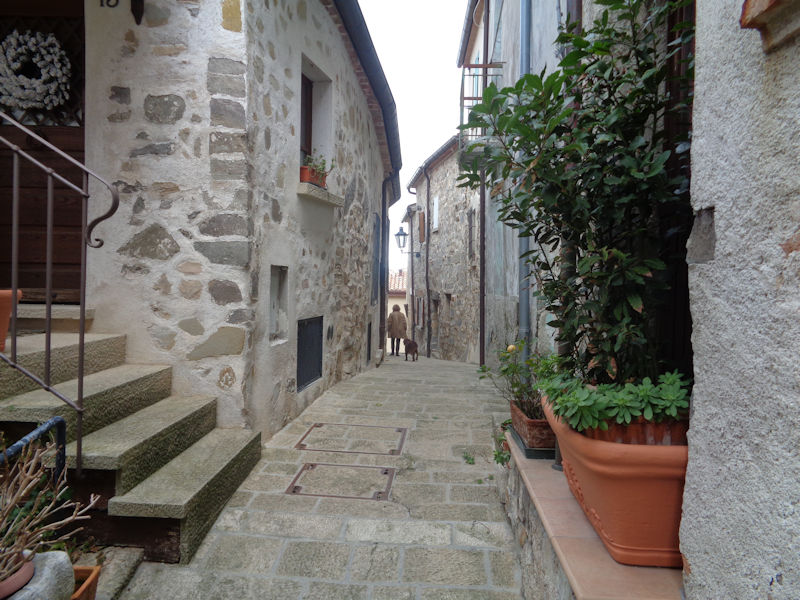
. . . and we'll have to come back for a little walkabout another day.

We're over the little castle hill and looking down on our patio.

Back to street level
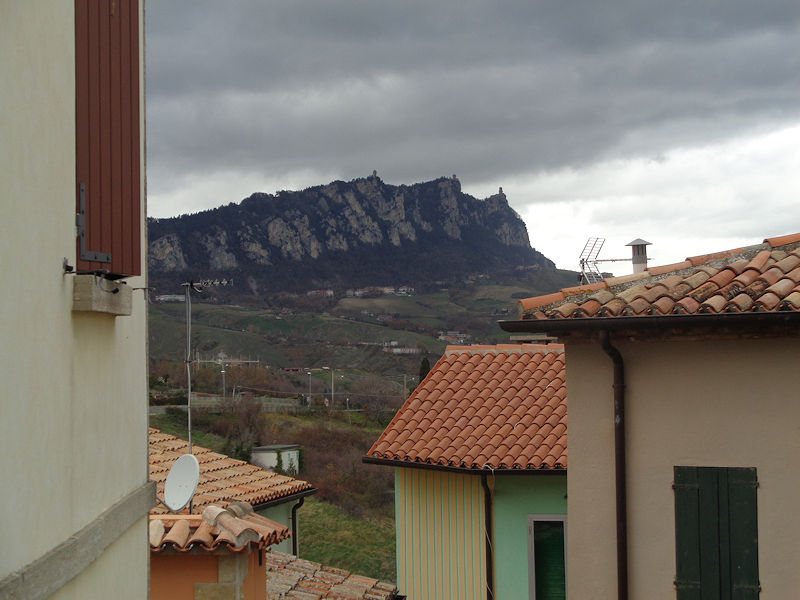
The three towers of San Marino itself, whither we are now bound.

Saint Marinus, a Croatian stonemason (we're told), founded a church and monastery here in 301 -- in the face of Diocletian persecution and, it seems, having been accused of marital irregularities (falsely, of course), he fled up Monte Titano (as in the photo) and founded a small church on the heights. Thus the official date of San Marino's founding is listed as 301 and it refers to itself as "the oldest extant sovereign state as well as the oldest constitutional republic".
San Marino in the rain

Thankfully, from the covered carpark No. 9 below town (half price with your hotel's card), there's an elevator up to the serious city walls.

The view from the elevator to the west. That San Marino is the oldest constitutional republic is sort of true, though for many of those centuries it was permitted to continue its republican institutions within the authority of the Papal States. Nonetheless, its legal documentary basis dates from the 16th century and is considered by many to be the earliest written constitution still in use. 'San Marino Historic Centre and Mount Titano' has been a UNESCO World Heritage cultural property since 2008.

And now just one more elevator to go.

And here we are at the real walls of the Città di San Marino, and . . .

. . . we proceed through the San Francesco gatehouse.

The sturdy oak doors of the San Francesco gatehouse, and the police officer permanently stationed outside to add some good order to the tourist traffic on foot and wheels.

Once inside the San Francesco Gate, we're greeted by a lovely nativity crèche and a museum of torture.

Up into town on the Via Basilicius. San Marino is the 5th smallest nation in the world evidently, and the 3rd smallest in Europe, a rare survival from the medieval era of city states each with its surrounding rural contado. At only 61 square kilometres, including the capital City and its nine 'castellos', and a population of about 34,000, it's one of only three countries that's entirely surrounded by another country, nestled into the Appennine foothills on the border between the Emilia-Romagna and Marche regions, 10km up the hill from coastal Rimini.

During the Lombard era, from the late 6th to the late 8th century, San Marino was a fief of the Duchy of Spoleto, evidently ruled by its bishop, like many other northern Italian cities, but evolving in the 10th century into an oligarchic commune type of administration, with an assembly formed of the heads of the leading families. In addition to that assembly, in 1243 daily administration was put into the hands of two elected Captains Regent, each serving a six-month term, a system which continues to the present.

Prices for eyeglasses are vastly lower in Italy than in Switzerland. In fact, San Marino was the first nation to have a properly elected communist government, a coalition of communists and socialists that was in power from 1945 to 1957 (it had been dominated by the Fascist Party from 1923 to 1943). Presently, the two Captains Regent are drawn each from the main rightist and leftist parties, and in recent years the rightist alliance of parties has won more seats than the leftist alliance in the unicameral 'Grand and General Council'. It's also had more female heads of state than any other nation. Though it's not a member of the European Union, it is permitted to use the euro (€) as its currency.

The Chiesa di San Francesco, across from the gate of the same name -- the Franciscans had had a church in the nearby parish of Murata, but plundering raids by the Malatestas of Rimini forced the brothers to petition the pope for permission to build a new one inside the walls of San Marino city . . .
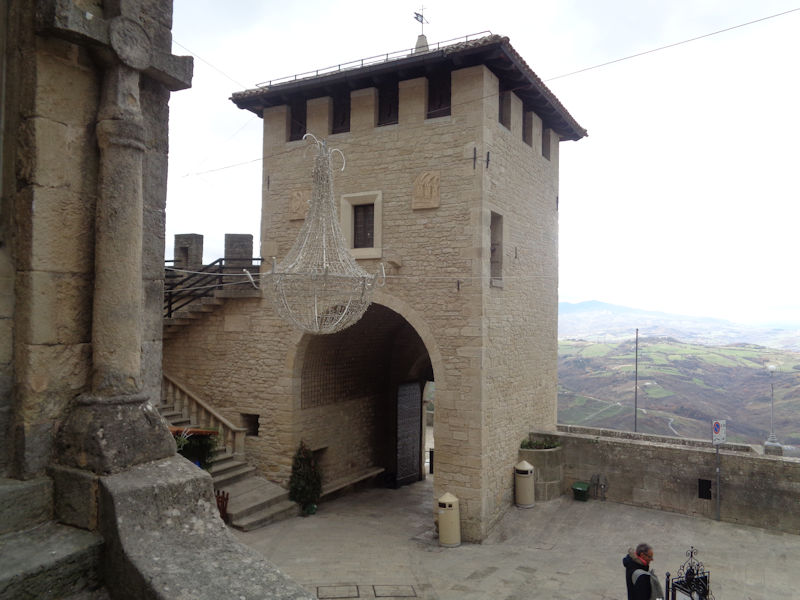
. . . which in 1361 they did, just within the contemporaneous San Francesco Gate, apparently transporting up the hill the construction materials from the old church and convent.
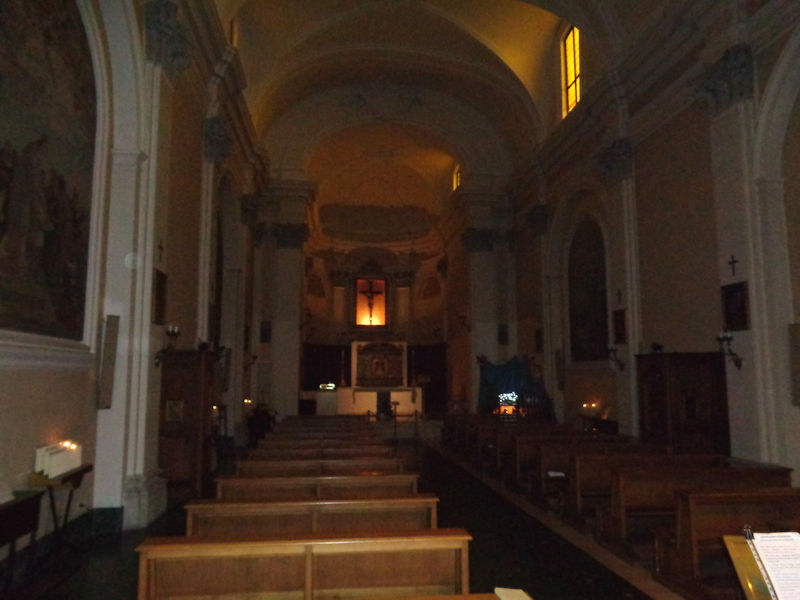
The church has been modified frequently over the centuries, but retains the original crucifix over the altar and a number of 15th century frescoes on the walls. Since 1966, the convent just behind the church has hosted the San Francesco Pinacoteca Museum.

The altar

Our discussions over eyeglasses must be nearing an end, and we'll be starting up into the town centre, but in the meantime . . .

. . . this purports to be the house where Giuseppe Garibaldi, in his flight over the mountains with the remnants of his Republican force and his pregnant and ill wife Anita after the French army successfully besieged Rome and restored the Vatican's temporal possessions, sought refuge on 31 July 1849 with the town fathers of neutral San Marino. The Sammarinese risked a great deal to protect his group whilst negotiating on his behalf with the pursuing Austrian army for guarantees that his surrender would not be met with a slaughter. The Austrians' terms were too harsh, and Garibaldi and some of his men slipped out of the city, found boats on the coast, and were chased by naval patrols to an island in the Comacchio lagoon called Magnavacca (modern Porto Garibaldi). Though Anita died of her illness en route, with the help of Republican patriots Garibaldi and a comrade eventually made it over the mountains to Tuscany and the sea (J. Ridley, Garibaldi, pp 322-44).
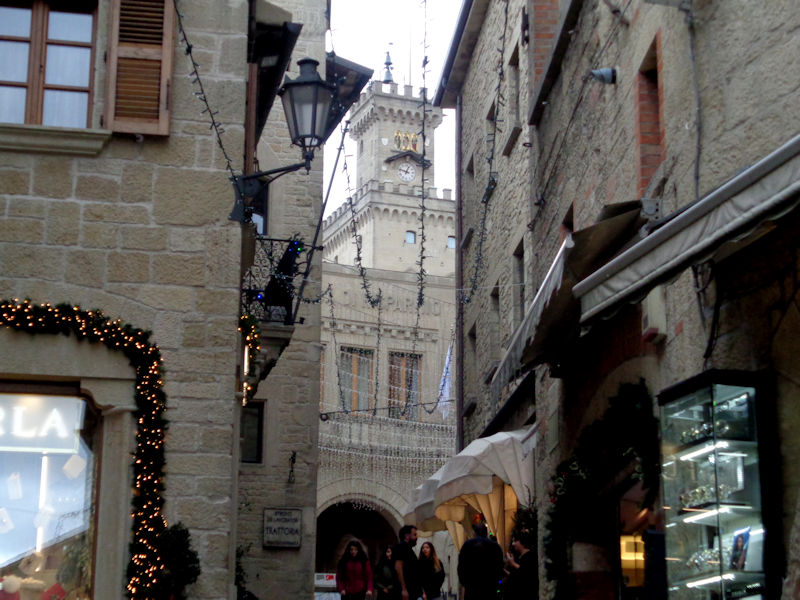
Approaching the Piazzetta del Titano (named for the mountain above us), with the Palazzo Pubblico towering in the background

The Piazzetta del Titano with (under the central arch) the Statua Grande Nudo Femminile (Big Female Nude Statue), by Francesco Messina (1982), in the collection of the bank, the Cassa di Risparmio della Repubblica di San Marino.

It's a pretty cold day to be standing around dressed like that.

Along the Via Eugippo, a small park under another set of city walls below the Palazzo Pubblico; we're walking out toward the northern end of the upper city.

Ready for the Christmas market

Sans paroles

The Cava dei Balestrieri (Crossbowmen's Quarry) -- responsibilities for national defense are performed by the Italian army, but historical elements of a San Marinese military past still remain. Aside from various ceremonial guards units (one of which still performs a 'changing of the guard' ritual for tourists) and the gendarmerie police force, which as elsewhere is part of the military, the ancient crossbow corps (the balestrieri) has survived since 1295, though now made up of volunteers and performing only ceremonial and recreational functions.

At the northern end of the city, we're looking down at Borgo Maggiore, with its funivia or cable car up into town.

A zoom view of central Borgo Maggiore. From the traffic roundabout, the road leading away opposite heads for Rimini, and the one off to the right goes southward under Monte Titano and, if you catch the right turnoff, down to Montegiardino.

From the funivia we are proceeding southwards towards the 'Liberty Square'.

Here's the Piazza della Libertà, with the originally 14th century Parva Domus Comunis, or Little House of the Commune, at the far end.

The broad terrace, with its government buildings, looking out over the city, reminds us of Gubbio in Umbria.
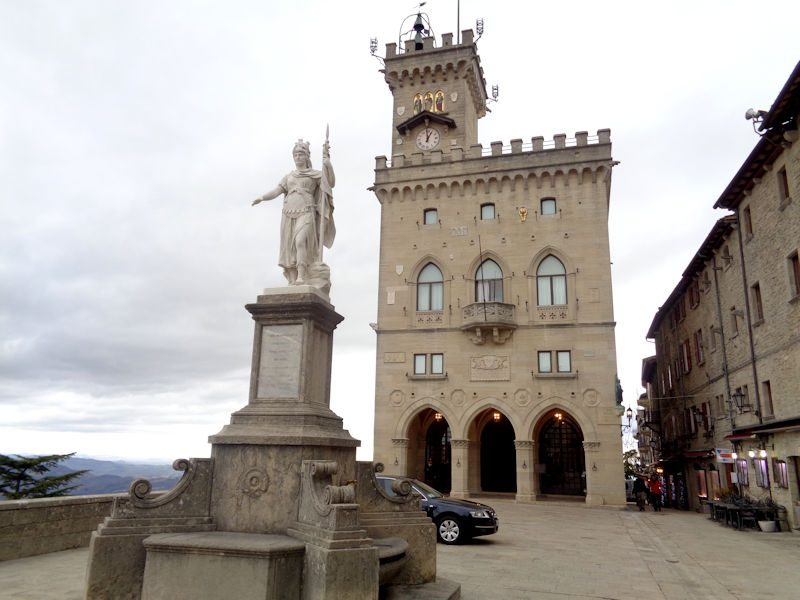
The Palazzo Pubblico, replacing a 14th-15th century city hall and designed in a neo-Gothic style, was inaugurated in 1894 and renovated in 1996. The Statue of Liberty dates from 1876.
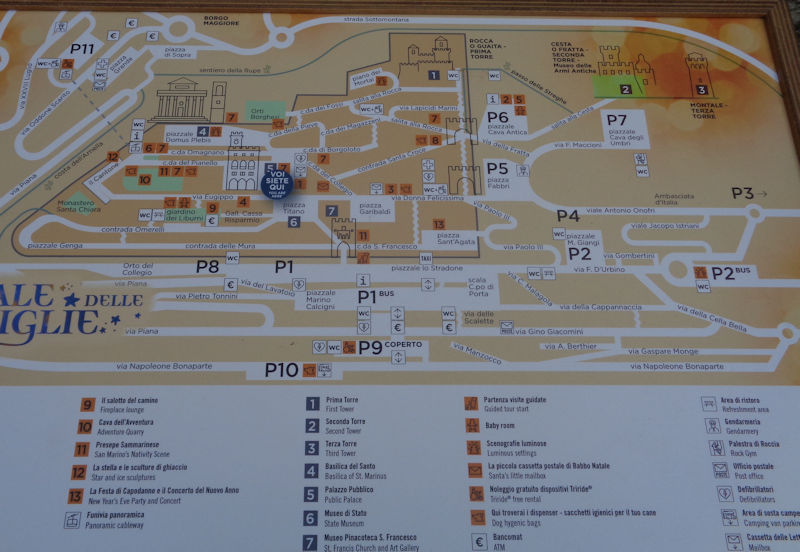
A pleasant map showing the locations of the Christmas presentations around town, as well as the three towers and main museums.

The Piazza della Libertà and the street up to the next level, with the Basilica di San Marino. But the rain is starting in in earnest now, and our party will separate for a while, half to lunch in a cosy dry place, half in a mad wet run up to Tower No. 1.

Kristin descending the Via Donna Felicissima towards the Ristorante Bolognese near the St Francis Gate (Donna Felicissima was a rich lady from Rimini who bequeathed the property here to the small Christian community that was growing up around St Marino's monastery.)

The rainswept Piazza Garibaldi (with a bust of that gentleman prominently displayed, and a styrofoam Santa Claus about to go up behind him), leading back up to the Piazza della Libertà and then . . .

. . . the Basilica di San Marino on the next level above that. Its predecessor church is first mentioned in extant documents from AD 530, but by the 19th century it was considered to be a deathtrap and knocked down to make way for this Neoclassical building, with its Corinthian columns out front, inaugurated in 1838. A piece of the skull and some other odds and ends, once belonging to San Marino himself and discovered in the old church in 1586, are in an urn under the altar. The building on the right dates from the 16th century, apparently -- in the crypt can be found (we've read), cut into the living rock of the mountain, the beds of both San Marino and his contemporary, San Leo or Leone of Montefeltro.

At the risk of being beaten to the pavement by this brutal rain, we're hurrying right past the Vampire Museum towards the top of the city to get a look at Tower No. 1, Castello della Guaita, or Torre Guaita. (The Vampire Museum is properly referred to as the Museo delle Creature della Notte - Vampiri e Licantropi; we really just don't have time for it on this trip.)

The Torre Guaita in its sodden glory, standing at 749m altitude within sight of the Adriatic Sea (on some days)

The town of San Marino was originally confined to the surroundings of the first monastery near the top of the Guaita peak of Monte Titano, but by the 11th century the fortification or rocca was needed to keep up with unfortunately changing times. It found its present form in the turbulence of the 15th century as the town struggled to maintain its independence against would-be conquerors.
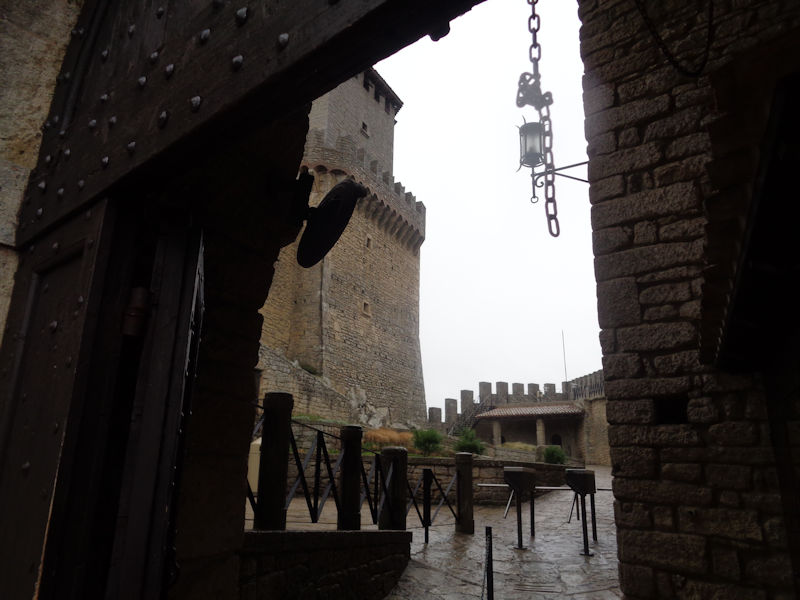
Like most medieval fortresses that have survived their post-artillery years of obsolescence, the First Tower served for many years as a prison. Alas, we don't have time to visit the castle today -- we're expected downtown seven minutes from now.

The rainy view from the clifftop adjacent to the Tower
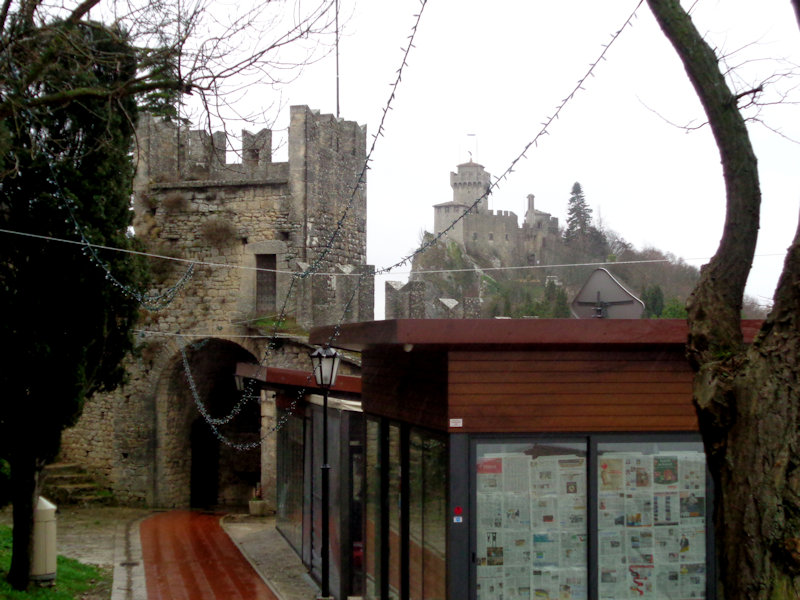
Just under the Guaita Tower, this is the topmost gatehouse in the inner city walls . . .
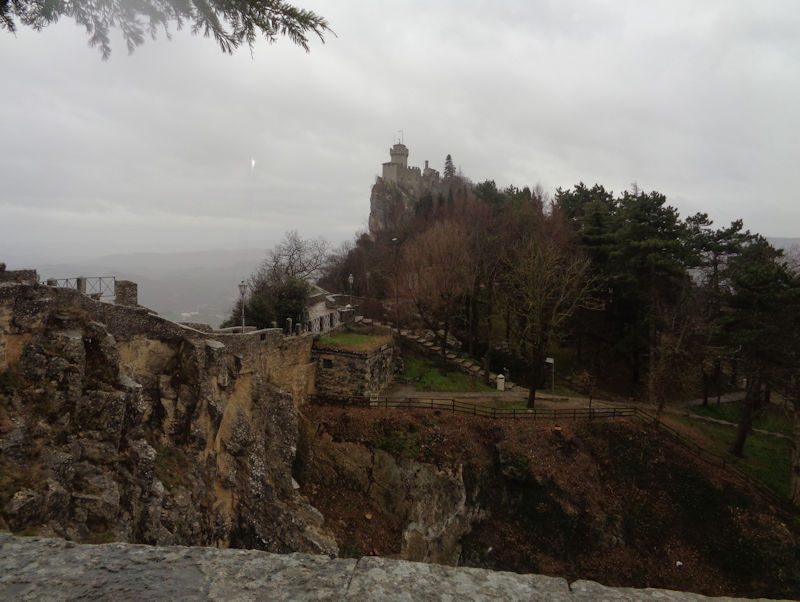
. . . leading along the Passo delle Streghe (the Witches' Walk, for some reason) to Tower No. 2, the Cesta Castle, on the highest of Monte Titano's three peaks at 756m.

The Cesta Tower -- we'll come back another day.

We're dripping down from the upper town, now passing the . . .

. . . Wax Museum (with instruments of torture!).

Poor old Garibaldi

The schoolkids are getting out for the day, and the camera's lens is fogging up.

The classic print of San Marino in 1757, blown up and hung on the wall of the Ristorante Bolognese

Our party's reunited, but the rain hasn't let up, so we'll make a brief sojourn hiding out in the Museo di Stato, begun in 1899 but relocated into the Palazzo Pergami Belluzzi in the central Piazzetta del Titano in 2001. A handful of images from the collections are appended here.

Subsequent to which, we're dodging raindrops unsuccessfully back down to our carpark.
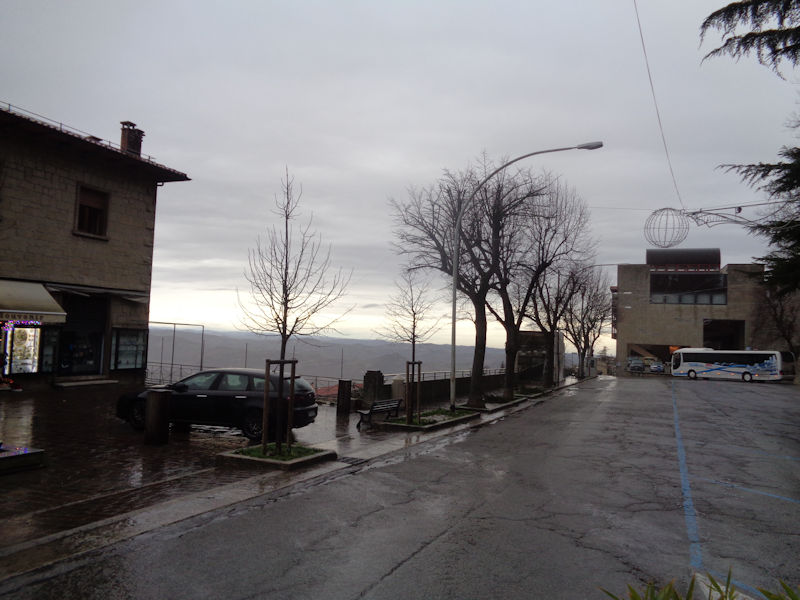
Several city layers down the hill.
We went back to San Marino for a rainless look round a few days later.
Tomorrow: A first visit to Rimini

 Dwight Peck's personal website
Dwight Peck's personal website















































































